 Panzer Model Identification and History
Panzer Model Identification and History |
 Panzer Model Identification and History
Panzer Model Identification and History |
 |
 |
||||||||||||||||
|
Jim Haynes has put together a great rundown of the history of the Panzer tractor. I've posted it as a .pdf file in the Free Downloads Section. It's #2 on the list. If you have anything to add, please send a note to info@panzertractors.com.  A few years ago, we acquired the entire collection of sales cards from Allen Lawnmower. These index cards listed model information, serial numbers and sales dates for Panzers sold from the mid '50s through the early '70s. This invaluable piece of history can help you identify your tractor's year of manufacture by comparing your serial number to like tractors and their sales dates. Please see the "Manuals & Downloads" section of the web site to view or download the database.  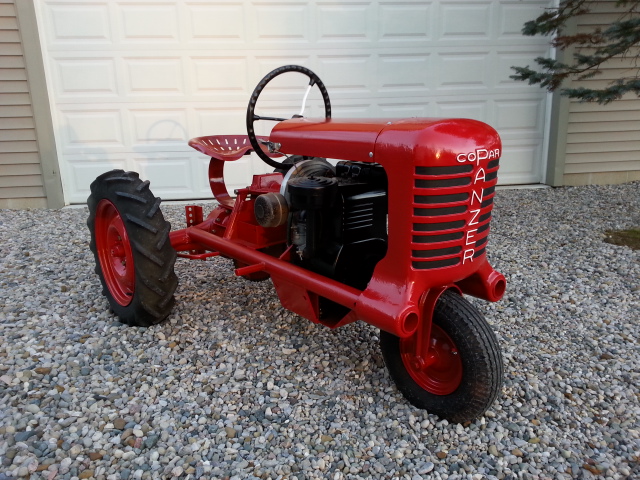 Model A (1954) The Model A was produced in College Park, Md. in 1954. Model A tractors will have a serial number stamped on the right side of the frame rail just aft of where it slides in to the front casting. As far as we can tell, approximately 350 tractors were produced in College Park, of which we have documented less than 50 to still exist. Copar was not good at keeping records, and most likely did not build the tractors in sequence. The serial number on the frame rail will be 3 digits and most likely less in value than 350. Model A Panzers were all red, powered by an 8 1/2 hp Model 23 Briggs & Stratton engine and had cast iron pulleys on both the engine and jack shaft. The jack shaft had the location "College Park, Md." and "Mod A." cast in to it, where later models had Laurel, Md. Advertising literature shows it had 6x16" tires on the rear, although at least one confirmed original Model A has 8x16" tires on it. Because they were made of cast iron and succeptable to cracking, the jack shaft casting and pulleys may not be a reliable way to identify a Model A. I have a Model A with a cast iron engine pulley and serial number stamped in the frame, but because the tractor was used extensively for mowing, it has a replacement jack shaft casting and a large pulley made of aluminum. The rims had been repainted with yellow paint and had 8x16" turf tires on it. However, when I took the tires off the rims, it was clear the original rim color was red. When production switched to Laurel, Md. in early 1955, the company began referring to them as a Model T102. Because of existing stock and repair parts, newer models of 3 and even 4 wheel Copar Panzers can have a jack shaft casting that says College Park. Jim Haynes (Dandy Sales) and I have had a lot of debates, and have agreed that only tractors produced in College Park should be called Model A. All others were built in Laurel and are called by their T100 or T200 model designations. For example, I have a 3 wheel Copar Panzer that looks exactly like a Model A. It has a serial number of 1947 stamped into the frame, but it is to the right of the tool box and not on the frame rail. It also has an aluminum engine pulley. Even though it says Mod A on the jack shaft housing, it also says Laurel, Md. Because of this, it is a T102 and not a Model A. If you want to identify your engine, there is a great source of serial numbers for Model 23 and 23A B&S engines online at http://www.asecc.com/data/briggs/data4.html I've added a picture of the info from that page below. Click on the thumbnail to view. Updated September 21, 2014
 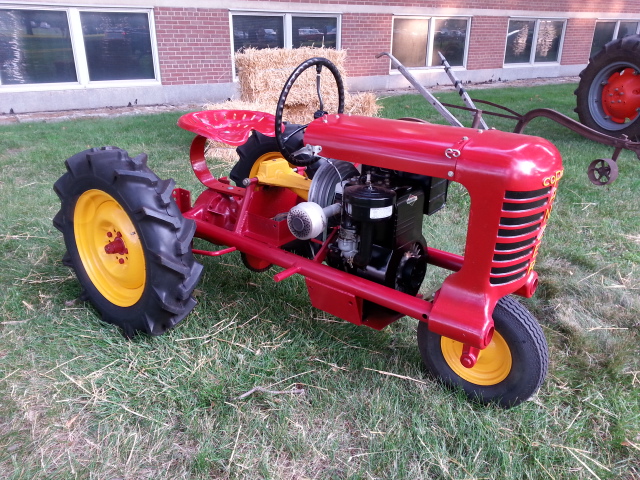 T100 and T200 Series Copar Panzers The T100 series was the evolution of the Model A. The T102 was produced starting in 1955 at the new Laurel, Md. plant. The 100 series has a single front wheel and is almost identical to the Model A except for aluminum engine and drive pulleys and yellow wheels and jack shaft housing. The jack shaft housing will say 'Laurel, Md" on it instead of College Park. Although it may say Mod A also on the jack shaft casting, these were referred to by Copar as T102. In 1957 a dedicated 4 wheel model called a T205 was introduced. This lasted until 1960 when Virginia Metalcrafters bought Copar and discontinued the line (see notes on the T220). The wide front end was adapted to existing 3 wheelers, so the steering shaft came out the right side and behind the front casting. Later T200 series tractors had improved front end geometry / design and the steering arm came out betwen the frame rails in the front. According to a Technical Bulletin dated July 23, 1958: Reinforcement of T102 & T205 Tractor Frames Beginning with Serial Numbers 3-0066 (T102) and 4-0143 (T205), the frame on al 9 HP Panzer tractors have been reinforced by a rod between the tractor frame pipes and over the forward end of the differential. It goes on to say that it was to reinforce the area where the frame pipes were welded to the axle housing - an area full of cracks on most tractors. My model A had a pipe welded between the rails, but it was added by the owner (along with other reinforcements to the engine cradle) when it was restored sometime in the past 60 years.
 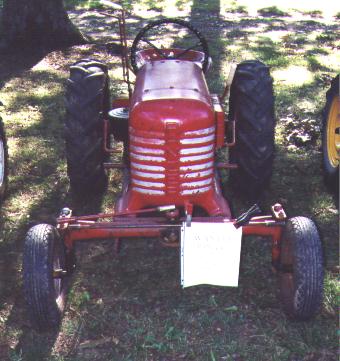 T220 Copar Panzer This was the last of the '9 hp' models. It featured a 9 hp Model 23A Briggs & Stratton engine, and rear tires were 8x16" Goodyears. They were built starting in 1959, and were discontinued after the last one had been sold in August, 1961. (Sales Bulletin 61147, August 1, 1961). Since Virginia Metalcrafters purchased Copar, Inc. on January 1, 1960, the tractors were built prior to July 1, 1960. (Per SB 6091, June 13, 1960.) I believe the Panzer in the picture is a T220, but it may be a T210.  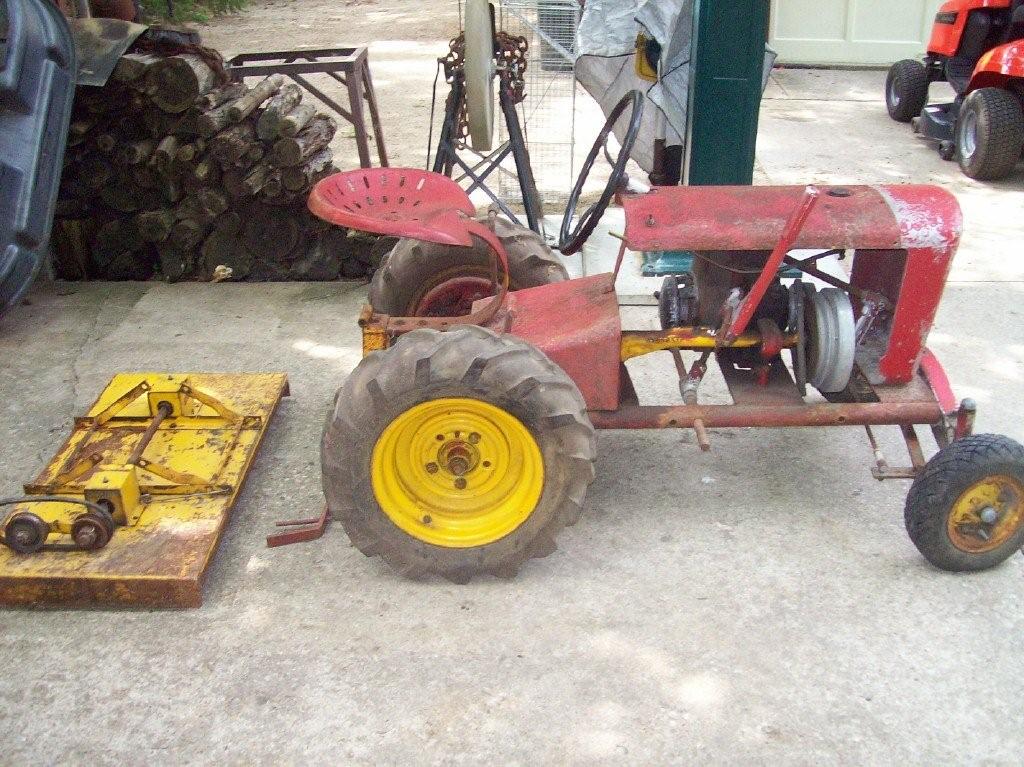 T50 Copar Panzer The T50 was the first in a line of 'small' panzers, starting in 1957 and running through late 1958. They have a couple of features of note:
 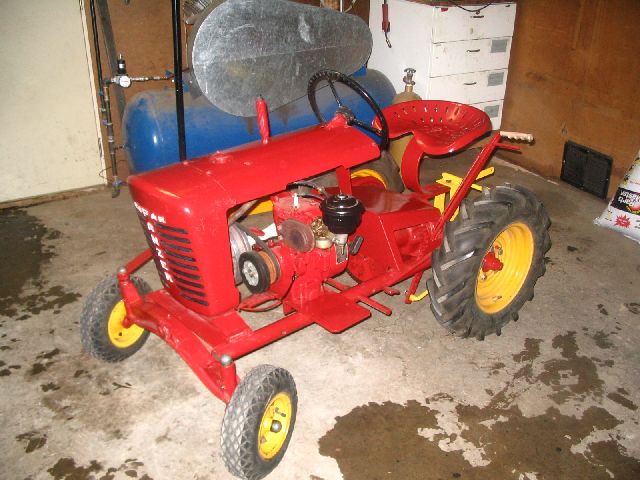 T55 Copar Panzer These were very similar to the T50, and described as an improved version of the 1957 T50. These may be the most rare model Copar Panzer. They started production in 1958, and were built along with the T50 and T60 as both 1958 and 1959 models. Some characteristics from a sales bulletin issued October 17, 1958 (I paraphrased this, and did not include all items):
The 1959 model had a rubber isolation plate (see T60 description below.) The picture shows one that we believe to be a T55, but it has a Kohler engine on it. The Clinton engine was not a good engine, so it may have been replaced with the Kohler.
 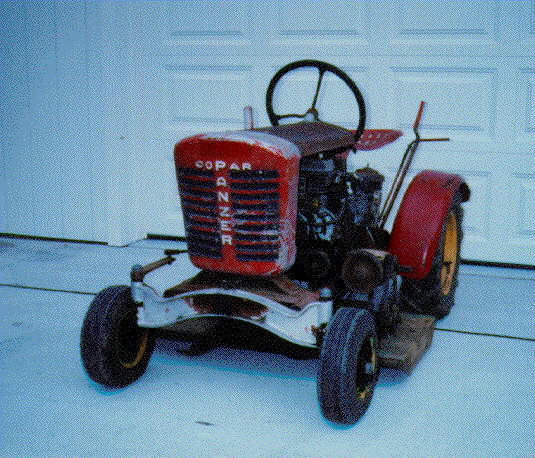 T60 Copar Panzer The T60 Copar Panzer was an evolution of the T55 in that it had a "more powerful and practical 5 3/4 hp" Briggs engine. These tractors were also red / black / white / yellow in color. They had an engine plate extension on the left hand side of the frame rail for the Model 51PT power take-off gearbox, which is different than the 50PT that will fit on the T50 and T55. According to the sales bulletins, T60s were produced in 1958 and 1959. They and the 1959 T55 both had rubber isolated engine plates that Copar called "shock mounted engines." (SB5820). In order to fit the Briggs engine, the hood needed to be raised. The T60 and T65 tractors share a raised piece of metal welded to the frame under the grille casting.  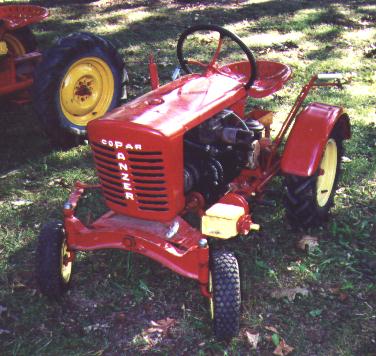 T65 Copar Panzer The T65 was similar to the T50-60 series, but can be identified by the PTO bracket on the left frame rail being forward of the engine (see picture). It was introduced as a 1960 model at the National Hardware Show September 28 through October 2, 1959 at the New York Coliseum. It had a 5 3/4 hp Briggs engine model number 143302. The T65 model color is "Tantalizing Turquoise with white accents, but many (most?) were painted red by the owners as in this picture. The red/yellow/black/white colors shown are correct for the T50, T55 and T60 tractors. You may find some models of T65 and T70 with a 'b' or 'bes' after them. B stands for Briggs & Stratton and the 'es' stands for electric start. There was a change to the 5 3/4 hp engine to a 6 hp engine, which may have prompted the extra letters. The engines were identical except the 6hp has the 'Easy Spin' feature on the cam shaft and a slightly shaved head for higher compression. There is also an 'Easy Spin' sticker on the engine. More details on this in a future article.
 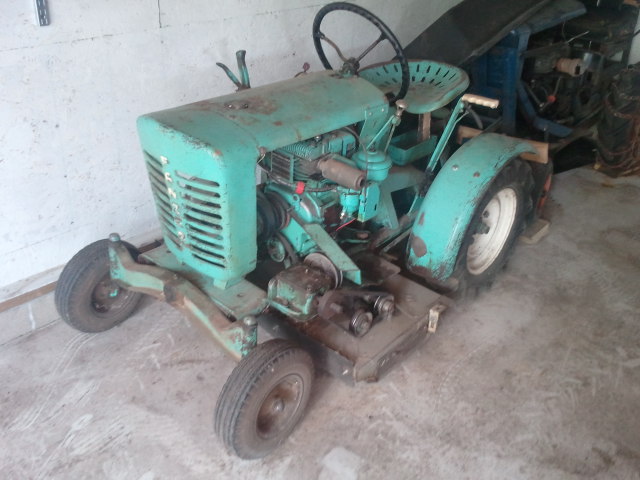 T70 Panzer When Copar was purchased by Virginia Metalcrafters in 1960, it appears they transitioned the T65 model into the T70 by changing parts that were cast aluminum into cast iron. The drive castings and other pieces were slowly changed to cast iron first on the T65, and (with the removal of the word Copar from the front grille) the T70 was born. They were probably trying to use up inventory from the T65 and produced a hybrid until they were out of Copar front grille castings. Other than the aluminum into iron and some other improvements, the T65 and T70 were virtually identical. A 6hp "Easy Spin" Brigg & Stratton engine replaced the 5 3/4 hp version early on. Easy Spin is a trade name for a mechanical compression release on the camshaft. If you have an original engine, it should have a sticker on the starter housing that says Easy Spin. A shaved head upped the overall compression, adding a remarkable 1/4 hp. It retained the air vane governor which can be used to identify whether you have an original type engine or if it has been replaced by a 7 or 8 hp engine with a mechanical governor. The engine was discontinued due to overheating issues in the early 1960s, and Briggs quit selling parts (including short blocks) for it. For this reason, the engines are hard to find. Fortunately, these engines were available on many brands of equipment from the 1950s, so you can find them occasionally. Pictured is a T70bes that was purchased new in 1961. Shortly thereafter, the electric starter stopped working, and it continued since then as a pull start. The original mower deck rusted out, so the owner re-created it with galvanized sheet steel. The drive engagement for the mower deck is much improved from the lever used on the T65 and older tractors - you just need to move it forward to engage the mower. You can see a video of this tractor mowing grass at www.youtube.com/panzerclub.  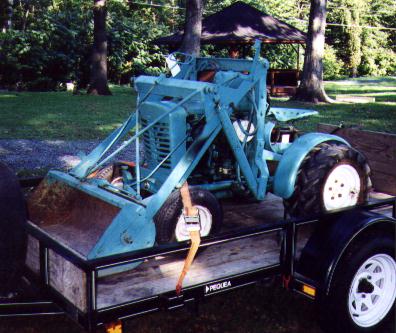 T707es and T707esl Copar reluctantly added a 7hp Kohler (K161s) engine to their tractors in 1962, and named it the T707es. According to SB 61153A dated Oct 12, 1961, they took orders until 12/31/61 and only produced the ones that were ordered. The Kohler engine was a $49 option for a T70es. The thumbnail picture is from a T707es that is the incorrect color, and is not completely assembled. According to a later sales brochure dated May 15, 1962, there was also a T707bes model. The b designation stood for Briggs & Stratton, so it appears the 7hp version may have switched over after the initial run of Kohlers. I don't have any record of a T707es being sold with a Briggs engine, though. The 7hp Briggs was a model 170402, but that engine was a common replacement for tractors in the 1960s and 70s. In August of 1962, the T707esl model was created and advertised as a 1963 model (SB 62168, Aug 13, 1962). The loader in the picture is the same one in the sales brochure. Pictures of the T707esl tractor in SB 62169 (8/27/62) appear to show an air cleaner from a Briggs engine, so these tractors may not have been built with the Kohler engine.
 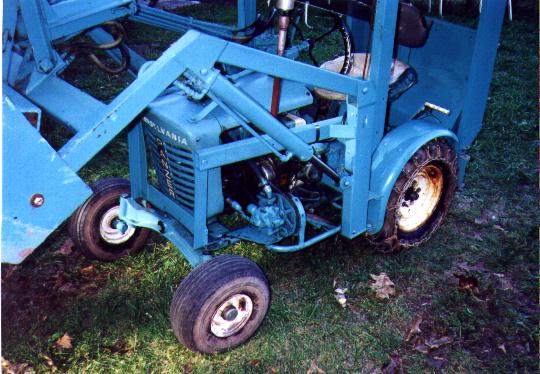 T75 and T75esl Pennsylvania Panzer The T75 started assembly on November 1, 1963 as a 1964 model, according to SB 63188 11/1/63. They featured a 6hp Briggs 142302 model engine. Later in 1966, that engine was replaced with the 7hp Briggs model 170402, according to the Allen Mower database.  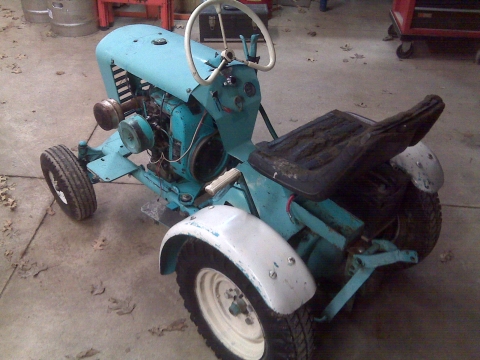 T758es Pennsylvania Panzer The T758es tractor is a T75 model with an 8hp Kohler K181s engine. Production started in mid-November, 1963, as they were waiting for an order of engines to arrive. The first T758es' had the word 'Panzer' cast into the grille. In later models, the word Panzer was replaced with a sticker.
 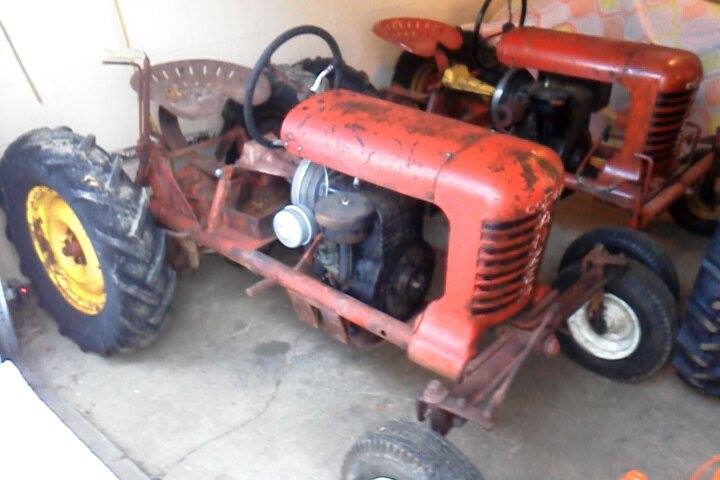 T115 and T215 Copar Panzer These models share characteristics of the T120 and T220, except they don't have an isolated engine mounting plate. More info to follow!
 If your engine is original on your large Panzer and you have the model and serial number, you can cross reference the build date. This will give you a minimum age, not necessarily the tractor build date. The tractor can't be older than the engine... Large Panzers had Model 23 or Model 23A Briggs & Stratton Engines. Go to the following web site, and click on the Technical data link on the left side. http://www.edgeta.com/ | Return Home | Model ID / History | Stories | Restoration | Part Sources | Free Downloads | FAQ | Pictures | Links | Donate Now! | Contact Us | |
|||||||||||||||||
 |
 |
